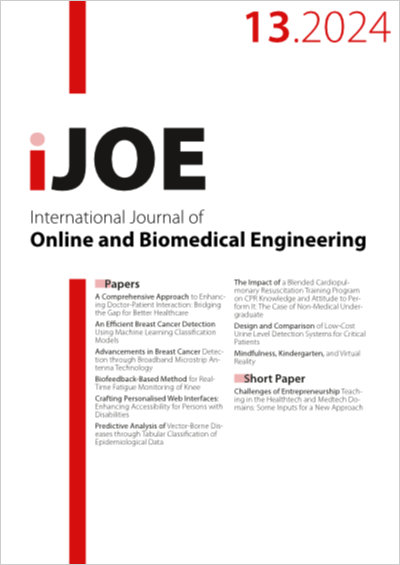Advancements in Breast Cancer Detection through Broadband Microstrip Antenna Technology
DOI:
https://doi.org/10.3991/ijoe.v20i13.50509Keywords:
UWB Band Antenna, Cancer patient, Sustainable fabrication, Bio-Medical Application, Good Health and Well-beingAbstract
In this paper, a novel method for detecting breast cancer utilizing an ultra-wideband (UWB) microstrip patch antenna operating in the UWB frequency range is presented. The promise of non-invasive, radiation-free breast cancer screening is provided by UWB technology. We give a brief overview of the difficulties in detecting breast cancer as well as the benefits of UWB technology in medical applications in this study. This study presents a compact printed microstrip patch antenna used for the bio-medical application at industrial, scientific, and medical (ISM) and UWB frequencies. The proposed antenna consists of a hexagonal-shaped microstrip patch antenna with a slotted ground antenna used for high bandwidth for a wider range of applications. The compact biomedical antenna is printed on Roger 5880 substrate with an overall dimension of 25*25 mm. Due to the high demand for results accuracy, Roger 5880 substrate material is used because it has good dielectric characteristics and loss factors that are appropriate for medical and radio frequency (RF) applications. A 50-ohm impedance line is used to feed the antenna. The proposed antenna has a higher bandwidth of almost 12.5 GHz at such a low frequency, starting from 3.53 to 16 GHz. The antenna has an acceptable gain of 3.38 Db, which is enough for the required application. The UWB microstrip patch antenna has the potential to improve breast cancer detection accuracy and reliability, which would aid in early diagnosis and better cancer patient treatment. This work represents a major advancement in the development of non-invasive, low-cost breast imaging methods for early cancer diagnosis.
Downloads
Published
How to Cite
Issue
Section
License
Copyright (c) 2024 Amer Alsaraira, Omar Saraereh , Samer Alabed

This work is licensed under a Creative Commons Attribution 4.0 International License.



